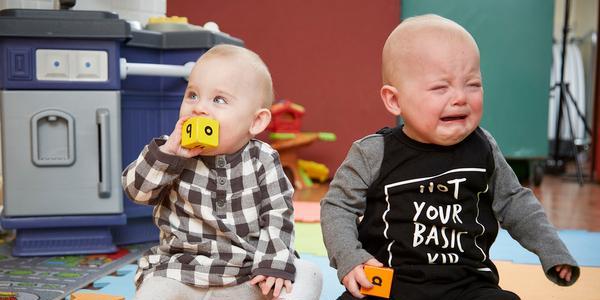Babies cry for different reasons. They may be hungry, tired, too hot or too cold, lonely, scared, poorly, in pain or need their nappy changed.
We provide some advice here on dealing with crying in your twins, triplets or more, however would always suggest that you seek medical advice if you have any concerns about your babies and the amount of time they cry. Speak to your health visitor or GP or call NHS 111 for advice.
How to deal with twins crying at the same time
If your babies are all crying at the same time it can be hard to cope with. You are not alone in finding it challenging but there are some things you can do to help deal with it.
- When tending to one baby, make sure you have the other babies close by - talk to them and reassure them and yourself that you are doing everything you can to get to them. There is nothing more you can do and if you get flustered and panicked then everything will take longer to complete.
- If you feel yourself getting desperate, take time out to calm down. Put the babies in their cots or a safe place then close the door and take a minute for yourself. When you go back to the babies, you will be in a much calmer state to deal with the situation which in turn can also calm the babies.
- Try to gradually develop some routine. As you get to know your babies better you will be able to identify quicker what they want when they cry.
- If you notice certain times of the day that are worse, try and get support at those times, to make things a bit easier for you.
- You could also ask a family member or friend to come over and look after the babies for half an hour so that you can go out. Even if you just walk around the block, the break will refresh you making it easier to cope when you get back.
Our helpline is here for you
If it feels like things are getting a bit too much then you don't need to go through it alone - our helpline is free and available to everyone. You'll be connected to a trained volunteer who is a fellow parent of twins, triplets or more and can provide advice or just a friendly listening ear from someone who understands.

How to calm crying twins
- Having useful equipment can be key to trying to settle more than one baby at once.
- Using a sling gives you a free hand to settle another in your arms or in a bouncy or rocker chair, but please make sure you are following the safety guidelines if you choose to use a sling.
- Alternatively, you may find they settle in the pram where they can be rocked. You might choose to have one or two in the pram and one in your arms depending on their need at the time.
- Some parents find dummies can offer instant comfort to an unhappy baby. Not all babies will suck a dummy though so don't worry if your babies won't.
- Music or a constant background noise can help soothe babies. White noise can be very popular and there are many different apps/white noise machines available, but make sure that it is specifically designed for babies so it is the right noise pitch.

Reasons for crying in twins
Research suggests that periods of prolonged crying in babies aged 2-12 weeks can be a normal stage of development. The Period of PURPLE Crying can help you to understand your babies' crying:
- P – Peak crying: your baby might cry more during the second month, then less in months three to five.
- U – Unexpected: crying can come and go and you don't know why.
- R – Resists soothing: your baby might not stop crying no matter what you try.
- P – Pain-like face: a crying baby might look like they are in pain, even when they are not.
- L – Long lasting: crying can last as long as five hours a day or more.
- E – Evening: your baby might cry more in the late afternoon and evening.
No one knows what causes colic. Doctors say it is like a tummy ache: your babies cry and you are unable to comfort them. It comes in waves and some babies seem to be affected more than others. You may have one baby who really suffers whereas the others don't. It can be extremely overwhelming if you have more than one baby who suffers with it. It can often be in the afternoon and evening when they are at their worst.
Often the way in which a doctor might diagnose colic is to follow the 'rules of 3' by asking if your baby is crying:
- at least three hours at a stretch and
- at least three days a week and
- for at least three weeks in a row?
Other signs that it might be colic can be when your baby:
- is hard to soothe or settle,
- clenches his/her fists,
- goes red in the face with the crying,
- brings their knees up to their tummy.
If this isn't the case it might be something else that is causing the pain and you should ask your doctor to explore this more with you.
Colic doesn't cause any actual harm and it does get better, usually by the time the babies are twelve weeks old or thereabouts. But it's very hard to deal with - even more so as there is no magic cure. To help relieve the symptoms of colic, when feeding consider:
- giving regular breaks throughout the feed,
- ensuring they are winded throughout,
- keeping the baby in a more upright position when feeding to help to stop them swallowing air,
- ensuring they are kept upright for 10-15 minutes at the end of the feed.
Other things that may help at the babies worse times include:
- giving your baby a warm bath,
- making changes to your diet if you are breastfeeding as some foods can cause greater wind and tummy pains for your baby,
- baby massage,
- playing music, white noise or similar to help distract baby,
- taking them out for a walk or drive - the pushchair, car or sling can often help soothe them.
Families have found the over-the-counter medication that you give around feed times very helpful for symptom alleviation. Always make sure you seek medical advice before using these.
When coping with a baby suffering from colic, you must also take care of yourself so you can cope. If you can, arrange to have someone drop in at the babies worse times so you can draw on their practical and moral support.
We can often feel guilty if one baby has particularly bad colic and needs more attention than the others during this period. The babies will need different levels of attention at different times so try and let go of this guilt. Make sure if you have a particularly fussy baby, that you have met all the needs of the less fussy babies first if they are likely to settle quicker.
If it all gets too much, place your babies safely in their cots or a safe place and step into another room for a minute. Take some deep breaths and calm yourself and work out what strategy you are going to try next. You can also contact our Twinline support helpline to speak with one of our trained volunteers.
Reflux is when babies are sick or bring up milk after feeding. Reflux often starts before the baby is eight weeks old and lasts until they are a year. It can be as a result of the muscles around their food pipe and stomach not being fully developed meaning can't keep all the milk down. It is very common and can go away on its own. It is more common in babies who are born prematurely or have other health complications.
Signs your baby may have reflux include:
- spitting up milk during or after feeds - this may happen several times a day,
- difficulty feeding - such as refusing feeds, gagging or choking,
- persistent hiccups or coughing,
- excessive crying, or crying while feeding,
- frequent ear infections.
Often your babies can be displaying these symptoms but not actually being sick. This is called silent reflux. Things you can try to help relieve reflux include:
- feeding babies in a more upright position and leaving them upright for 20 minutes after the feed. Utilising your bouncy chairs or feeding pillow is helpful if you are on your own at feed times rather than laying them straight back down in a flat cot. Always make sure you supervise the babies following the feed.
- changing nappies before you start the feed rather than after,
- considering reducing the amount of milk in each feed and giving the feeds at more regular intervals.
- when winding, try rubbing and gently circling rather than patting.
- considering a staggered feeding schedule if all your babies suffer with symptoms, so you can fully concentrate on the individual feeds until the symptoms are under control.
Your GP may have further treatments to help if the symptoms are causing much distress to your babies, including medication and milk thickeners. These should only be used under the guidance of your medical professionals. If these don't help then your baby may be referred for further tests.
More information on reflux in babies can be found on the NHS website.
You can also find further information and support from Cry-sis.
-strap.svg)